Estuaries are unique ecosystems where the saltwater from the ocean mixes with the freshwater from rivers and streams. These areas serve as important nurseries, breeding grounds, and feeding habitats for a wide variety of wildlife, including birds.
Although estuaries cover a small portion of the earth’s surface, they support a diverse range of bird species that rely on the rich food sources and shelter provided by these ecological zones.
From wading birds to raptors, estuaries provide a vital ecosystem for many bird species, making estuaries important to both birds and humans.
In this article, we will explore some of the bird species that inhabit estuaries and their significance within these ecosystems.
1. American Wigeon
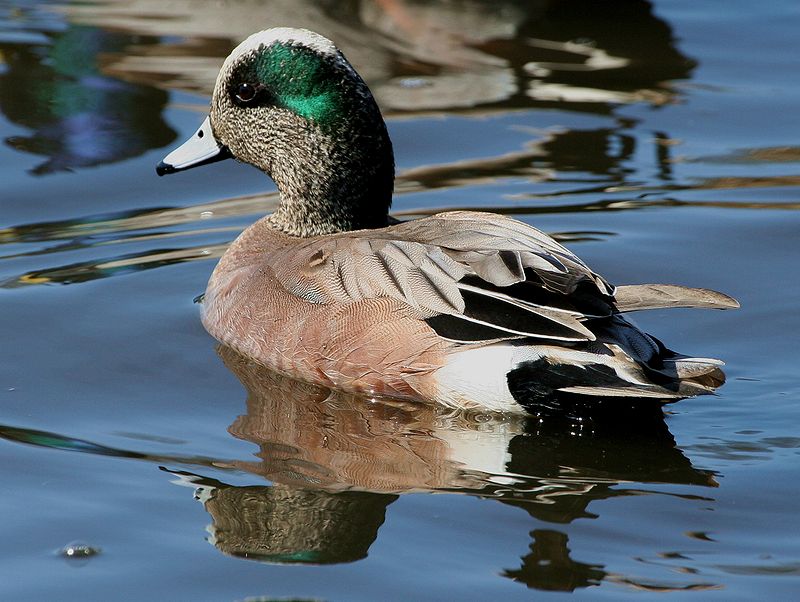
The American Wigeon, also known as the Baldpate, is a species of dabbling duck found throughout North America.
It closely resembles its Eurasian counterpart and was formally described in 1789 by German naturalist Johann Friedrich Gmelin.
This medium-sized bird has an overall grey body with white feathers on its face and belly that give it a distinctive bald appearance.
Its wings are brownish black with green speculum markings on them while the tail is dark brown or black at the base and gradually lightens near the tips to become chestnut-colored.
The male wigeons have purple patches on their heads during breeding season along with yellow eyes which helps differentiate them from females who have duller colors around their faces instead of bright ones like males possess.
Scientific classification:
| Kingdom | Animalia |
| Phylum | Chordata |
| Class | Aves |
| Order | Anseriformes |
| Family | Anatidae |
| Genus | Mareca |
| Species | M. americana |
Also Featured In: Most Popular Bird Species in North America, British Columbian Birds
2. Canada Goose
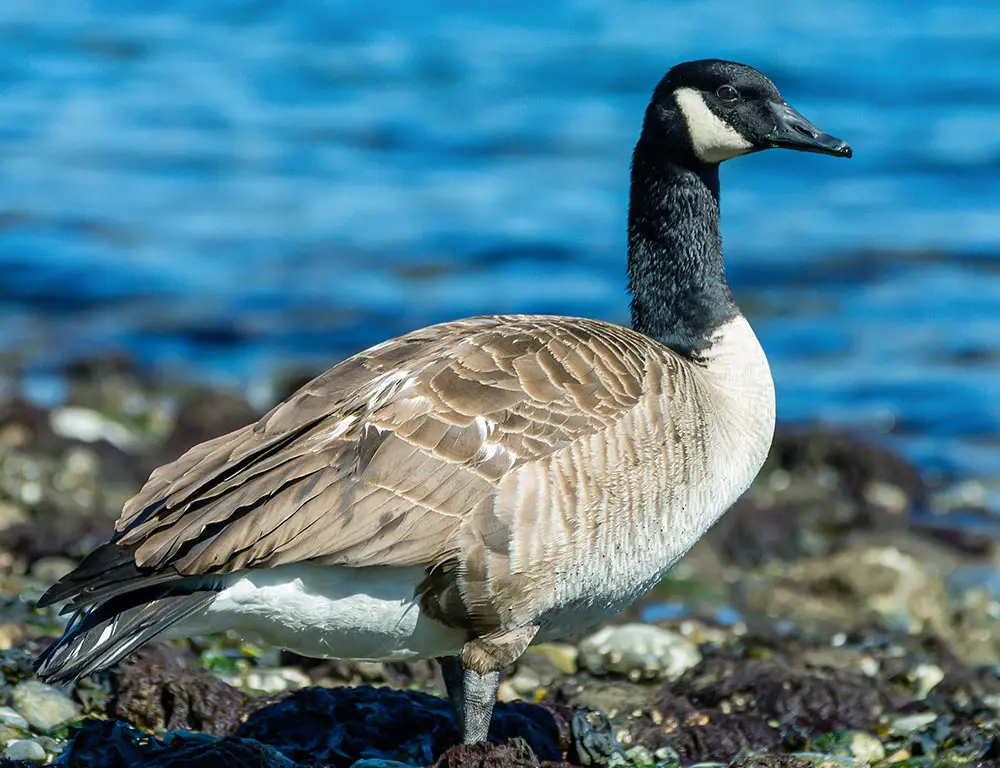
The Canada goose is a majestic bird with a black head and neck, white cheeks, chin, and brown body. It’s native to North America but occasionally migrates to northern Europe across the Atlantic.
The species has been introduced in the United Kingdom, Ireland, and Finland as well. Canada geese are strong flyers that travel in flocks for protection from predators; they also form monogamous pairs for life.
They feed on grasses or grains near ponds or wetlands where they make their nests of down which incubate eggs during summertime before hatching them out into goslings later on.
Scientific classification:
| Kingdom | Animalia |
| Phylum | Chordata |
| Class | Aves |
| Order | Anseriformes |
| Family | Anatidae |
| Genus | Branta |
| Species | B. canadensis |
Also Featured In: Birds Live in Arkansas, Most Common Lake Birds
3. Dunlin

The Dunlin is a small wader, formerly known as part of the stint family. It has dull brown feathers and its name is derived from the dialect word “dunling”.
This bird breeds in Arctic or subarctic regions during summer months but migrates to warmer climates during winter.
The Dunlin feeds on insects and invertebrates which it finds in mudflats and shallow waters.
During breeding season they form large flocks that can contain thousands of birds. They are also well-known for their impressive synchronized flight patterns that look like a wave moving through the sky.
Scientific classification:
| Kingdom | Animalia |
| Phylum | Chordata |
| Class | Aves |
| Order | Charadriiformes |
| Family | Scolopacidae |
| Genus | Calidris |
| Species | C. alpina |
Also Featured In: Flight Birds You Should Know, Shetland Islands Birds You Should Know
4. Bar-Tailed Godwit
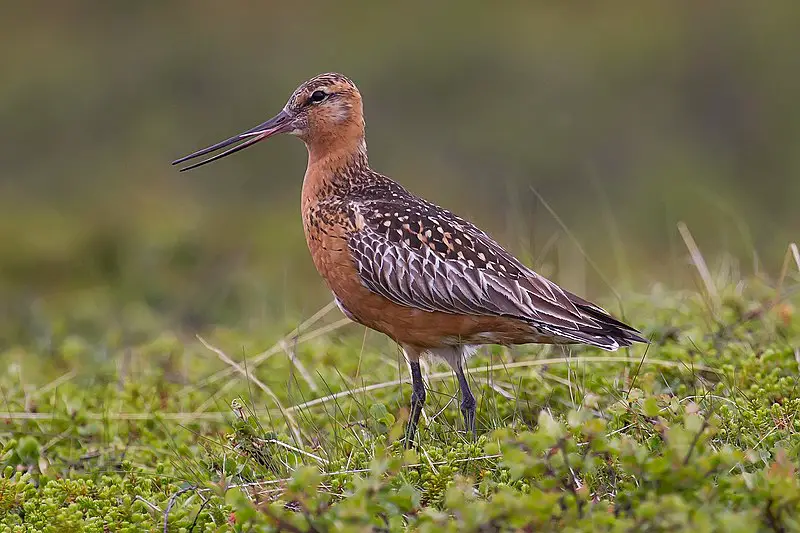
The bar-tailed godwit is a remarkable bird, both in its appearance and behavior. Its striking red breeding plumage stands out amongst the typical browns of other waders.
Long legs help it traverse coastal mudflats and estuaries where it forages on bristle worms and shellfish.
It has an upturned bill that gives it further distinction from other shorebirds.
Bar-tailed godwits breed on Arctic coasts stretching to Alaska during summer months before migrating south towards warmer temperate or tropical regions for wintering each year – quite incredible.
Despite their long migratory journeys, they are still considered a common species due to large numbers making these arduous trips annually, although some populations have experienced declines recently.
Scientific classification:
| Kingdom | Animalia |
| Phylum | Chordata |
| Class | Aves |
| Order | Charadriiformes |
| Family | Scolopacidae |
| Genus | Limosa |
| Species | L. lapponica |
Also Featured In: Russian Birds, Tundra Birds
5. Great Blue Heron
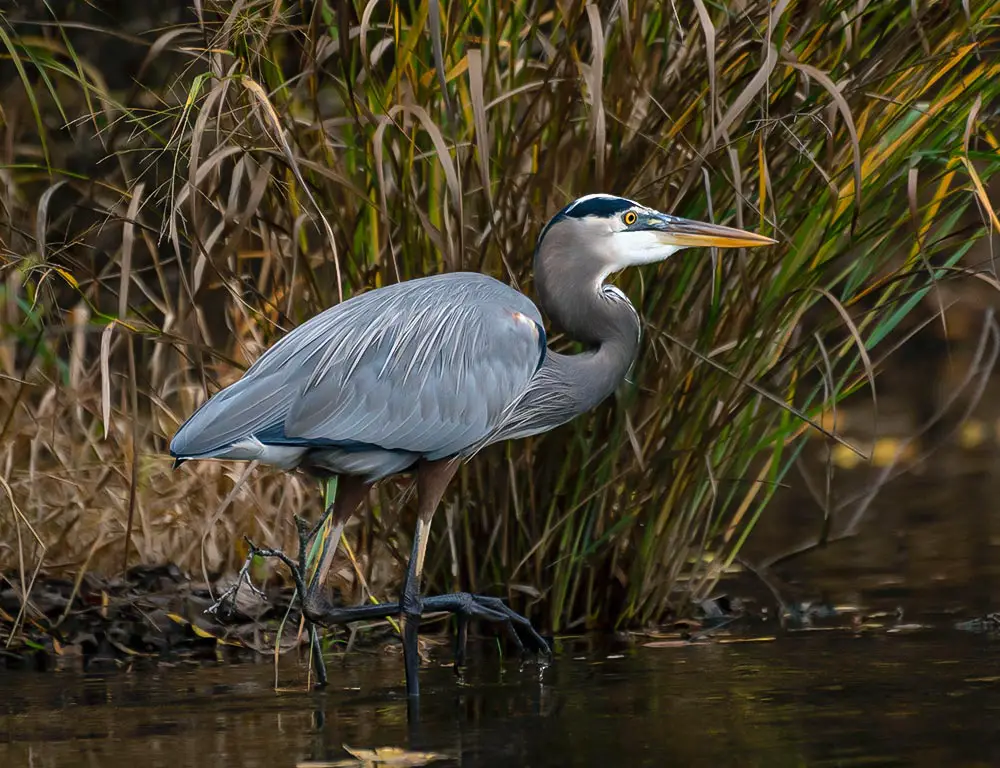
The Great Blue Heron is a majestic wading bird found in many parts of North America, Central America, the Caribbean, and even as far away as the Galapagos Islands.
It has an impressive wingspan which can reach up to six feet wide. Its feathers are mainly bluish-gray with brownish streaks on both its neck and chest while its head displays white plumes.
The adult herons can also be identified by their yellow bill and legs.
They live near bodies of water such as lakes, marshes, or rivers where they feed on fish using a spear-like motion with their sharp bills.
An all-white population exists only in South Florida and the Florida Keys making it unique.
Scientific classification:
| Kingdom | Animalia |
| Phylum | Chordata |
| Class | Aves |
| Order | Pelecaniformes |
| Family | Ardeidae |
| Genus | Ardea |
| Species | A. herodias |
Also Featured In: Common Birds in Canada, Birds That Live in Colorado
6. Black-Tailed Godwit
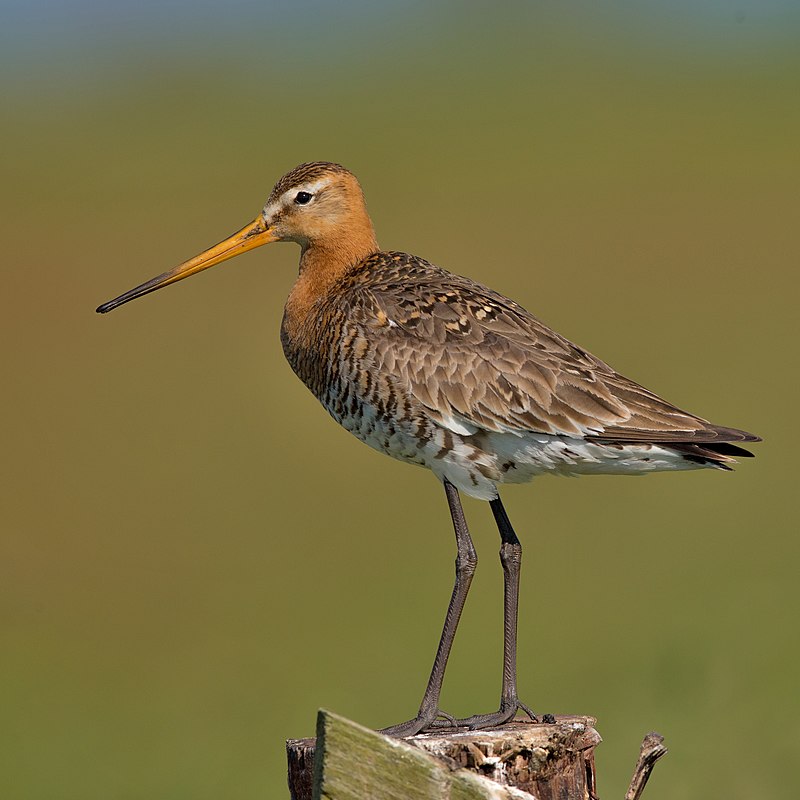
The Black-tailed Godwit is a species of large shorebird that was first described by Carl Linnaeus in 1758.
These beautiful birds have an orange head, neck, and chest during breeding season while they turn to grey-brown coloration in winter.
They are easily identifiable due to their black and white wing bar throughout the year. As for their habitat, these godwits breed mostly in Iceland but also across Europe, eastward through Asia Minor to Mongolia; some even winter further south in Africa or India.
The Godwit has adapted well to human presence as it can be found close to wetlands near farms or villages where plenty of food is available from plowed fields.
It’s amazing how such a majestic bird with colorful plumage manages so successfully in this day and age.
Scientific classification:
| Kingdom | Animalia |
| Phylum | Chordata |
| Class | Aves |
| Order | Charadriiformes |
| Family | Scolopacidae |
| Genus | Limosa |
| Species | L. limosa |
Also Featured In: Birds in Sri Lanka, Belarus Birds You Should Know
7. Brant
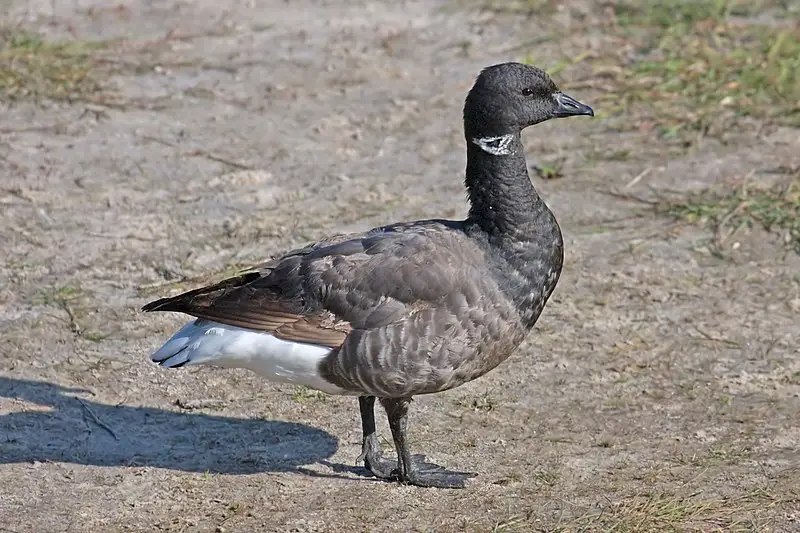
The Brent Goose, also known as the Brant or Bernicla goose, is a small species of waterfowl belonging to the genus Branta. It has three subspecies that live along temperate coastlines and breed on high-Arctic tundras.
This species can be identified by its short stubby bill, which measures between 22-26 inches long and 42-48 across its wingspan when fully grown.
They typically weigh between 0.88 – 2 lbs depending on location and seasonally changing diets they may consume while in flight or at rest stops during migration routes they take annually from one region to another.
The Brent Oilfield was named after this bird due to its abundance in certain areas near bodies of water where it would gather for safety during migrations over land formations such as mountain ranges or other geographical features that could otherwise become difficult obstacles if not avoided altogether.
Scientific classification:
| Kingdom | Animalia |
| Phylum | Chordata |
| Class | Aves |
| Order | Anseriformes |
| Family | Anatidae |
| Genus | Branta |
| Species | B. bernicla |
Also Featured In: Ireland Birds, Birds that Live in Greenland
8. Brandt’s Cormorant
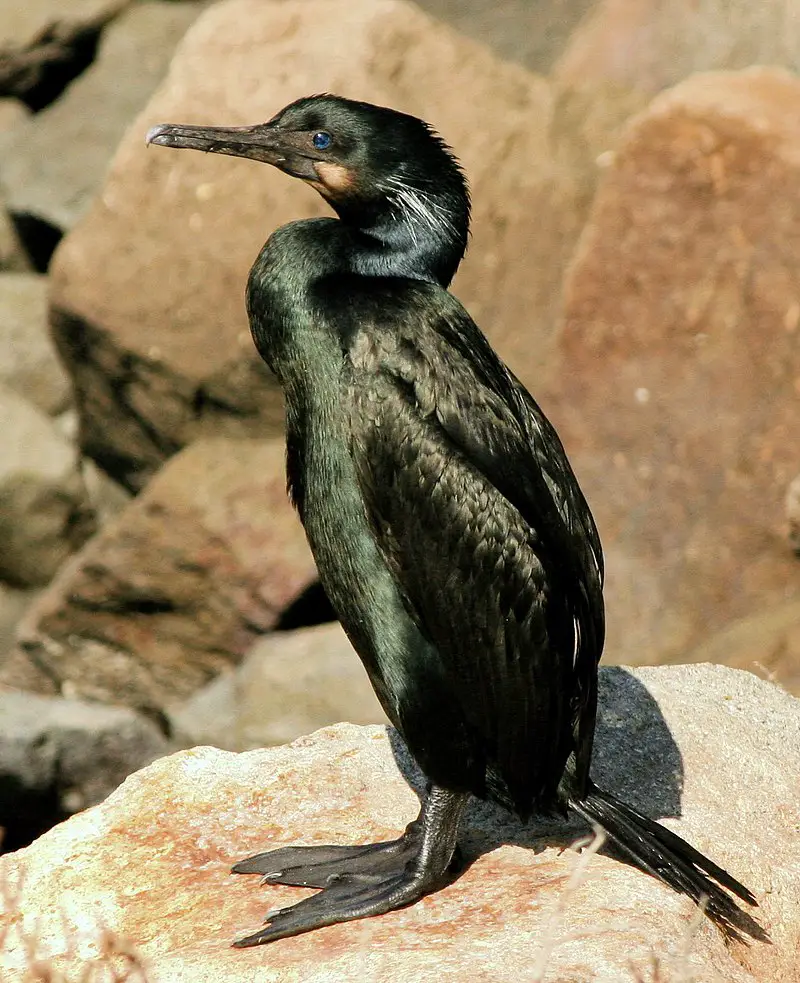
Brandt’s cormorant is a seabird of the Cormorant family that inhabits the Pacific coast of North America.
In summer, it can be found from Alaska to the Gulf of California but its population northwards migrates south during the winter season.
Its name Penicillatus originates from Latin which means painter’s brush referring to its white plumes on the head and neck.
It feeds mainly on small fish like herring, anchovy, etc., diving up to 30 m deep for food caught in cold water near shorelines or at sea around offshore islands or continental shelves.
They breed along rocky shorelines building nests out of seaweed and sticks close together in colonies numbering hundreds while producing two eggs per year with an incubation period lasting 25-35 days before chicks fledge after seven weeks post-hatching.
Brandt’s cormorants are considered an important species as they help maintain a balance between marine predators and prey by controlling populations through their diet habits.
Scientific classification:
| Kingdom | Animalia |
| Phylum | Chordata |
| Class | Aves |
| Order | Suliformes |
| Family | Phalacrocoracidae |
| Genus | Urile |
| Species | U. penicillatus |
Also Featured In: Cormorant Species, Birds You’ll Find in the Sea
9. Western Snowy Plover
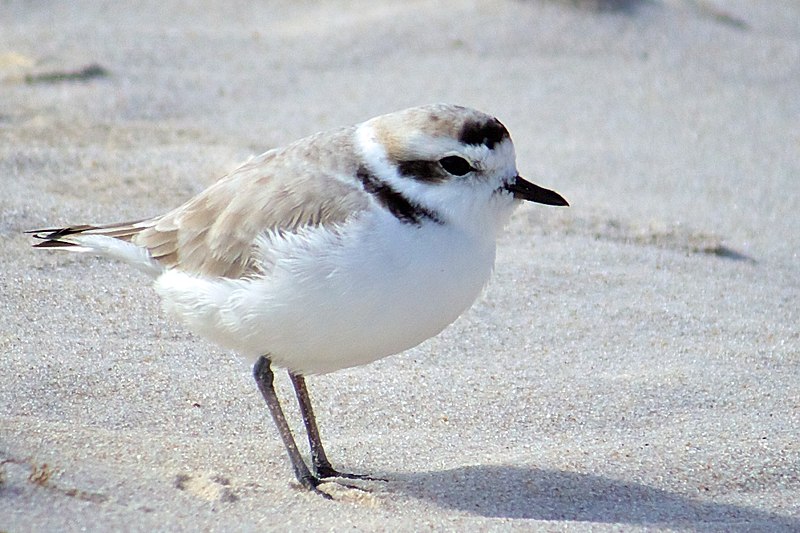
The western snowy plover is a small wader belonging to the plover bird family. It breeds in various areas of the United States and the Caribbean, but its population has been decreasing over time due to habitat loss and other threats.
For this reason, on March 5th, 1993 it was listed as threatened species under the Endangered Species Act of 1973.
To protect their habitats along California’s coast, Oregon’s coast, and Washington’s coasts they have also been designated as critical habitats by The U.S Fish & Wildlife Service in 2012.
Conservation efforts are being taken for these birds including beach closures during nesting season; however, more needs to be done if we want them safe from extinction. We must take action now before it’s too late.
Scientific classification:
| Kingdom | Animalia |
| Phylum | Chordata |
| Class | Aves |
| Order | Charadriiformes |
| Family | Charadriidae |
| Genus | Charadrius |
| Species | C. nivosus |
| Subspecies | C. n. nivosus |
Also Featured In: Common Californian Birds, Birds that Live in San Francisco Bay Area
10. Sandpiper
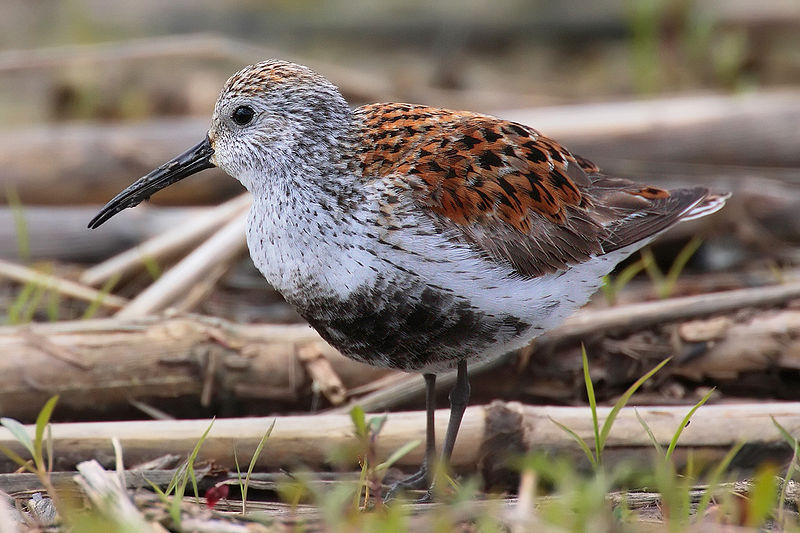
Sandpiper is a type of wading bird that belongs to the family Scolopacidae. It is a diverse family that includes various species such as curlew and snipe.
Sandpipers have different bill lengths that allow them to feed on small invertebrates and creatures found in mud or soil.
Due to this diversity, different species can coexist in the same habitat without competing for food.
Sandpipers are commonly found near the coast but are also found in other wetland environments.
They are known for their slender legs, long beak, and streamlined body that enables them to move easily in and out of water.
Sandpipers are a unique and fascinating bird species that are interesting to observe in their natural habitat.
Scientific classification:
| Kingdom | Animalia |
| Phylum | Chordata |
| Class | Aves |
| Order | Charadriiformes |
| Suborder | Scolopaci |
| Family | Scolopacidae Rafinesque, 1815 |
Also Featured In: Turkey Birds You Should Know, Ukrainian Birds You Should Know
11. Bufflehead
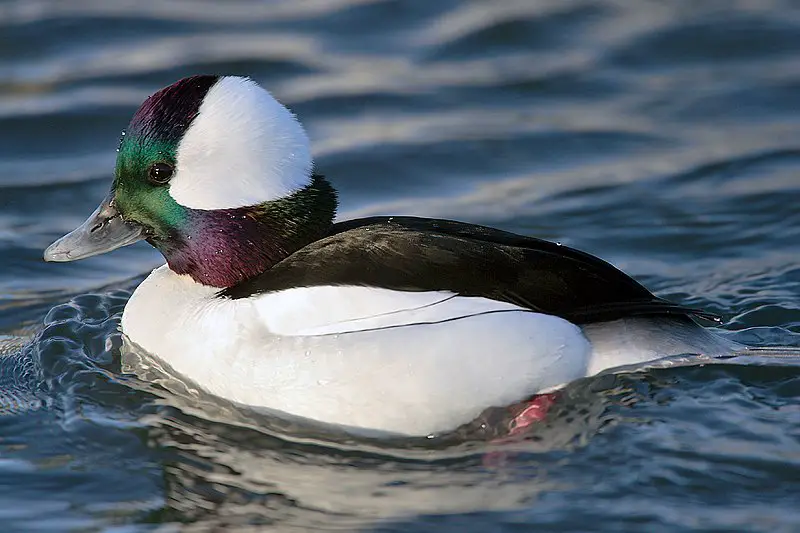
The Bufflehead bird is a small sea duck belonging to the Goldeneyes genus. It was first described in 1758 by Carl Linnaeus, and its scientific name is Bucephala albeola.
The name “Bucephala” comes from the Greek word for “bull-headed,” which refers to its oddly shaped, bulbous head.
These birds are known for their striking black and white plumage, with the males sporting distinctive iridescent green and purple feathers on their heads.
Buffleheads are found primarily in North America, spending their winters on coastal waters and migrating inland to breed in wooded areas.
They are skilled divers and feed primarily on insects and small crustaceans. Despite their small size, Buffleheads are hardy birds and can survive in extreme weather conditions.
Scientific classification:
| Kingdom | Animalia |
| Phylum | Chordata |
| Class | Aves |
| Order | Anseriformes |
| Family | Anatidae |
| Genus | Bucephala |
| Species | B. albeola |
Also Featured In: Water Birds Live around Us, Acadia National Park Birds
12. Western Sandpiper
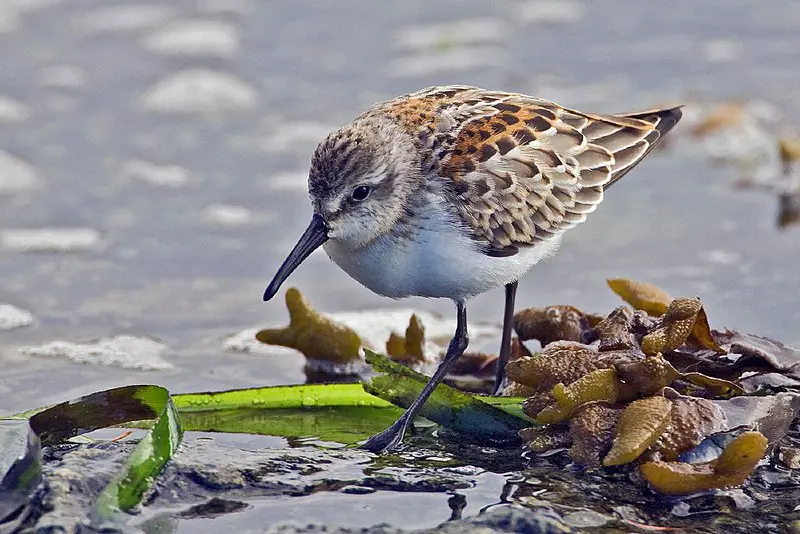
The Western sandpiper is a small shorebird found in North America. Its genus name, Kalidris, comes from the Ancient Greek term used by Aristotle for some grey-colored waterside birds.
The species name, mauri, is named after Italian botanist Ernesto Mauri. This species is one of the most abundant shorebirds in North America, with a population in the millions. Western sandpipers have dark legs and a short, straight bill.
They are often seen running quickly along the shorelines, probing the sand for insects and small crustaceans.
During the breeding season, they nest in the Arctic tundra, and during migration, they can be found on mudflats and beaches along the Pacific Coast as well as inland shallow freshwater wetlands.
Scientific classification:
| Kingdom | Animalia |
| Phylum | Chordata |
| Class | Aves |
| Order | Charadriiformes |
| Family | Scolopacidae |
| Genus | Calidris |
| Species | C. mauri |
Also Featured In: Birds in Pacific Northwest, Most Common Oaxaca Birds
To Recap
The journey through the beauty and diversity of 12 estuarine birds has offered a captivating glimpse into the fascinating world of these avian inhabitants of coastal ecosystems.
From the elegant grace of the great egret to the vibrant hues of the American avocet, each bird possesses its unique charm and adaptations for life in estuaries.
This photographic exploration underscores the critical role estuaries play in supporting a rich tapestry of avian life.
As we marvel at their beauty, it is a reminder of our responsibility to protect these fragile habitats and the birds that rely on them, ensuring a harmonious coexistence between nature and human activities.